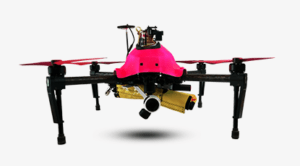
It’s an application that just makes sense. Lifeguards can stay on shore and monitor a large swath of coastline using a drone, including areas that may be beyond a wave break. When they spot a swimmer in trouble, they can release a life buoy to the swimmer to keep them afloat while emergency personnel reach them, or launch an appropriate response.
In December of 2015, firefighters in Rio de Janeiro, responsible for protecting the world-famous Copacabana beach during the southern hemisphere’s summer season, announced that they would deploy lifeguarding drones to augment patrols by boat and life raft. Since then, German drone manufacturer microdrones successfully demonstrated their lifeguarding drone, equipped with a compact life-saving device, to Germany’s lifeguarding association. The US, France, and New Zealand have also announced that they have implemented drones to help lifeguards patrol dangerous waters.

French authorities announced that the use of French-manufactured HELPER drones on France’s Atlantic beaches would be increased after a successful launch this season, one that resulted in the drones being used to help more than 50 swimmers. (A significant boost, perhaps, to drone giant DJI‘s running tally of lives saved by drone.)
The New Zealand Herald announced that lifeguards on the world-famous – and dangerous – Muriwai beaches would be experimenting with drone technology this season, which they hope will significantly boost safety on the beach, at an extremely low cost compared to adding more helicopter coverage.
In the US, it may be a while before lifeguarding drones are a common sight right on the beach, as current regulations make patrols over people problematic. But drones are used in San Diego and other communities by lifeguards to monitor the ocean for sharks near the shore, and use is sure to increase as regulations allow.
Regardless of public opinion about the use of recreational drones, drone technology is providing a lifeline – literally – to the teams responsible for monitoring beaches around the world.

Miriam McNabb is the Editor-in-Chief of DRONELIFE and CEO of JobForDrones, a professional drone services marketplace, and a fascinated observer of the emerging drone industry and the regulatory environment for drones. Miriam has penned over 3,000 articles focused on the commercial drone space and is an international speaker and recognized figure in the industry. Miriam has a degree from the University of Chicago and over 20 years of experience in high tech sales and marketing for new technologies.
For drone industry consulting or writing, Email Miriam.
TWITTER:@spaldingbarker
Subscribe to DroneLife here.